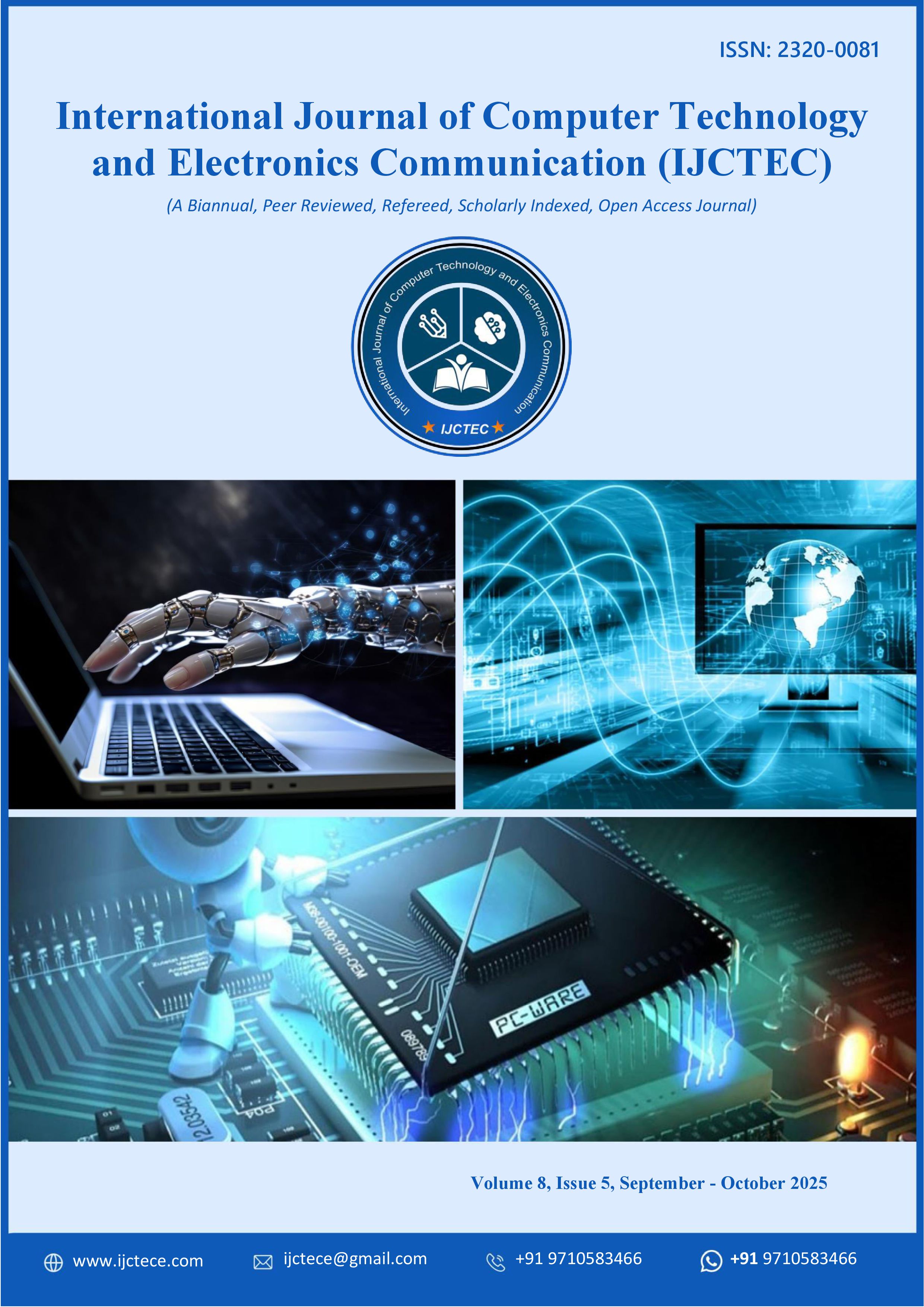Integrating Reinforcement Learning and BERT Models for Intelligent Cryptocurrency Transactions in Multi-Cloud SAP S/4HANA Systems
DOI:
https://doi.org/10.15680/IJCTECE.2025.0805016Keywords:
Artificial Intelligence (AI), Reinforcement Learning (RL), BERT, Cryptocurrency, SAP S/4HANA, Multi-Cloud Integration, Digital Payments, Blockchain, Natural Language Processing (NLP), Intelligent Financial Systems, Cloud Computing, Fraud Detection, Automated Decision-Making, Enterprise Resource Planning (ERP)Abstract
The rapid evolution of digital finance and enterprise technologies necessitates intelligent, secure, and adaptive transaction systems capable of operating across heterogeneous cloud environments. This paper introduces a novel AI-driven framework that integrates Reinforcement Learning (RL) and Bidirectional Encoder Representations from Transformers (BERT) to enhance cryptocurrency transaction management within multi-cloud SAP S/4HANA ecosystems.
The proposed architecture employs RL agents to autonomously optimize transaction routing, resource allocation, and gas-fee management across multiple blockchain networks, ensuring cost efficiency and scalability. Concurrently, BERT-based natural language models are utilized to interpret, validate, and classify transaction data, enabling advanced anomaly detection, sentiment-driven market prediction, and intelligent fraud prevention. By incorporating these AI models into SAP S/4HANA’s cloud-based ERP infrastructure, the system achieves seamless integration between enterprise financial processes and cryptocurrency operations.
Experimental simulations demonstrate improved throughput, reduced latency, and enhanced decision accuracy compared to conventional rule-based payment systems. The results underscore the transformative potential of combining Reinforcement Learning, BERT, and multi-cloud integration for next-generation, intelligent digital payment and cryptocurrency management solutions within enterprise frameworks.
References
1. Agrawal, A., Gans, J. S., & Goldfarb, A. (2018). Prediction Machines: The Simple Economics of Artificial Intelligence. Harvard Business Review Press.
2. Reddy, B. T. K., & Sugumar, R. (2025, June). Effective forest fire detection by UAV image using Resnet 50 compared over Google Net. In AIP Conference Proceedings (Vol. 3267, No. 1, p. 020274). AIP Publishing LLC.
3. Lee, J., Bagheri, B., & Kao, H. A. (2015). A cyber-physical systems architecture for industry 4.0-based manufacturing systems. Manufacturing Letters, 3, 18-23.
4. Christadoss, J., Panda, M. R., Samal, B. V., & Wali, G. (2025). Development of a Multi-Objective Optimisation Framework for Risk-Aware Fractional Investment Using Reinforcement Learning in Retail Finance. Futurity Proceedings, 3.
5. Reddy, B. T. K., & Sugumar, R. (2025, June). Effective forest fire detection by UAV image using Resnet 50 compared over Google Net. In AIP Conference Proceedings (Vol. 3267, No. 1, p. 020274). AIP Publishing LLC.
6. A. K. S, L. Anand and A. Kannur, "A Novel Approach to Feature Extraction in MI - Based BCI Systems," 2024 8th International Conference on Computational System and Information Technology for Sustainable Solutions (CSITSS), Bengaluru, India, 2024, pp. 1-6, doi: 10.1109/CSITSS64042.2024.10816913.
7. Manyika, J., et al. (2017). A future that works: Automation, employment, and productivity. McKinsey Global Institute.
8. Karanjkar, R., & Karanjkar, D. (2024). Optimizing Quality Assurance Resource Allocation in Multi Team Software Development Environments. International Journal of Technology, Management and Humanities, 10(04), 49-59.
9. Komarina, G. B., & Sajja, J. W. (2025). The Transformative Role of SAP Business Technology Platform in Enterprise Data and Analytics: A Strategic Analysis. Journal of Computer Science and Technology Studies, 7(5), 228-235.
10. Batchu, K. C. (2023). Cross-Platform ETL Federation: A Unified Interface for Multi-Cloud Data Integration. International Journal of Research Publications in Engineering, Technology and Management (IJRPETM), 6(6), 9632-9637.
11. Arjunan, T., Arjunan, G., & Kumar, N. J. (2025, May). Optimizing Quantum Support Vector Machine (QSVM) Circuits Using Hybrid Quantum Natural Gradient Descent (QNGD) and Whale Optimization Algorithm (WOA). In 2025 6th International Conference for Emerging Technology (INCET) (pp. 1-7). IEEE
12. Russell, S., & Norvig, P. (2016). Artificial Intelligence: A Modern Approach (3rd ed.). Pearson.
13. Manda, P. (2025). DISASTER RECOVERY BY DESIGN: BUILDING RESILIENT ORACLE DATABASE SYSTEMS IN CLOUD AND HYPERCONVERGED ENVIRONMENTS. International Journal of Research and Applied Innovations, 8(4), 12568-12579.
14. Nurtaz Begum, A., Samira Alam, C., & KM, Z. (2025). Enhancing Data Privacy in National Business Infrastructure: Measures that Concern the Analytics and Finance Industry. American Journal of Technology Advancement, 2(10), 46-54.
15. Shah, D., & Pathak, S. (2021). Artificial intelligence in banking: The changing landscape of digital finance. International Journal of Financial Studies, 9(2), 35.
16. Shokouhyar, S., Seddigh, M. R., & Panahifar, F. (2021). Digital banking transformation: A conceptual framework for emerging economies. Technological Forecasting and Social Change, 166, 120624.
17. Stone, P., Brooks, R., Brynjolfsson, E., et al. (2016). Artificial intelligence and life in 2030. One Hundred Year Study on Artificial Intelligence: Report of the 2015-2016 Study Panel.
18. Kondra, S., Raghavan, V., & kumar Adari, V. (2025). Beyond Text: Exploring Multimodal BERT Models. International Journal of Research Publications in Engineering, Technology and Management (IJRPETM), 8(1), 11764-11769.
19. Poornima, G., & Anand, L. (2024, May). Novel AI Multimodal Approach for Combating Against Pulmonary Carcinoma. In 2024 5th International Conference for Emerging Technology (INCET) (pp. 1-6). IEEE.
20. Adari, V. K. (2024). How Cloud Computing is Facilitating Interoperability in Banking and Finance. International Journal of Research Publications in Engineering, Technology and Management (IJRPETM), 7(6), 11465-11471.
21. Zerine, I., Biswas, Y. A., Doha, Z., Meghla, H. M., & Polas, M. R. H. (2025). Understanding Behavioral Intentions to Use Cryptocurrency for the Future of Digital Finance: Evidence from Bangladesh. Journal of Comprehensive Business Administration Research.
22. Sivaraju, P. S. (2024). PRIVATE CLOUD DATABASE CONSOLIDATION IN FINANCIAL SERVICES: A CASE STUDY OF DEUTSCHE BANK APAC MIGRATION. ITEGAM-Journal of Engineering and Technology for Industrial Applications (ITEGAM-JETIA).
23. Raju, L. H. V., & Sugumar, R. (2025, June). Improving jaccard and dice during cancerous skin segmentation with UNet approach compared to SegNet. In AIP Conference Proceedings (Vol. 3267, No. 1, p. 020271). AIP Publishing LLC.
24. Thambireddy, S., Bussu, V. R. R., & Mani, R. (2024). Optimizing SAP S/4HANA Upgrades through Sum: The Role of Silent Data Migration (SDMI) in Downtime Reduction. International Journal of Research and Applied Innovations, 7(3), 10727-10734.
25. Raju, L. H. V., & Sugumar, R. (2025, June). Improving jaccard and dice during cancerous skin segmentation with UNet approach compared to SegNet. In AIP Conference Proceedings (Vol. 3267, No. 1, p. 020271). AIP Publishing LLC.
26. Zhang, Y., & Lu, X. (2024). Quantum computing and AI for next-generation business intelligence. Journal of Business Analytics, 7(1), 44-59.


